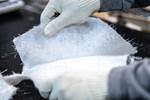Monadnock HTAC Veil protects GFRP equipment against corrosion
Binder-free ECTFE-apertured reinforcement maintains a high resistance against chemicals and abrasion at high temperatures, extending performance and integrity of composite systems.
GFRP pipes using the HTAC Veil. Photo Credit: Monadnock Non-Woven (MNW)
Monadnock Non-Wovens LLC (MNW, Mt. Pocono, Pa., U.S.) is introducing HTAC Veil, a new generation of veils used in the corrosion barrier of fiberglass-reinforced plastic (GFRP) equipment. MNW designed and developed the binder-free HTAC-apertured veil using meltblown ethylene chlorotrifluoroethylene (ECTFE) fluoropolymer resin.
The provides benefits such as high chemical and abrasion resistance at high temperatures and excellent fire retardancy (it maintains a flame spread index of zero per ASTM E-84). According to the company, the material also significantly extends the performance, integrity and life of GFRP tanks, tankers, scrubbers, pipes, ducts and stacks.
HTAC Veil has a high resistance against strong acids, sodium hydroxide, sodium hypochlorite, chlorine dioxide and solvents. With a high permeation resistance, it also reduces blistering in hot concentrated hydrochloric acid. It has an apertured hole pattern of IPS-10 and is easy to inspect in a 100 mils GFRP corrosion barrier.
As with all MNW products, HTAC is manufactured with renewable electricity.
Related Content
-
Welding is not bonding
Discussion of the issues in our understanding of thermoplastic composite welded structures and certification of the latest materials and welding technologies for future airframes.
-
The potential for thermoplastic composite nacelles
Collins Aerospace draws on global team, decades of experience to demonstrate large, curved AFP and welded structures for the next generation of aircraft.
-
Assembling the Multifunctional Fuselage Demonstrator: The final welds
Building the all-thermoplastic composite fuselage demonstrator comes to an end with continuous ultrasonic welding of the RH longitudinal fuselage joint and resistance welding for coupling of the fuselage frames across the upper and lower halves.



